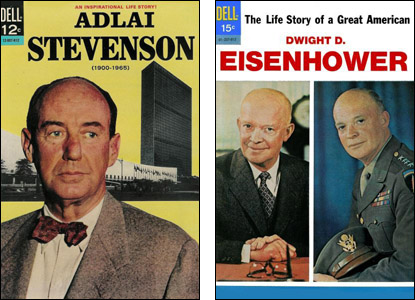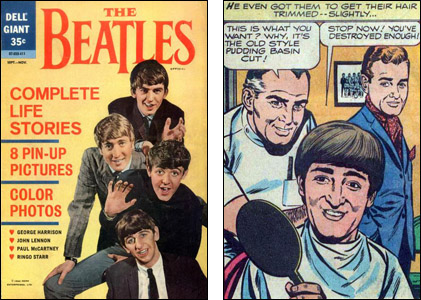
Here are three more "biography" comics that Dell put out in the sixties. Adlai Stevenson was drawn by Jack Sparling while the life story of Dwight D. Eisenhower was illustrated by Jose Delbo. It wouldn't surprise me if Walter B. Gibson wrote both of them. It also wouldn't surprise me if these and the other political ones were done as part of some deal that involved selling educational materials to schools. They were distributed to regular newsstands but I'm guessing the initial impetus was to hawk them via other channels.
The Dell line was then full of funny animal, ghost comics and a whole lot of monsters…and I somehow can't see the editors who turned Dracula into a super-hero saying, "You know what the kids really want? A comic about the late United Nations ambassador and twice-failed presidential candidate, Adlai Stevenson!" It came out in 1966, not long after he passed away and what's odd is that they may have made money off it. The Eisenhower book was done after Ike's death in '69 and it's unlikely they'd have done it if they'd lost a bundle on Adlai.

You'd assume they made tons o' money off their 1964 Beatles book but that might not be so, even though it went into a second printing. The book itself was quite pleasant. The art was by Joe Sinnott with an assist from Dick Giordano who pencilled the chapter on George Harrison. The script by the super-prolific Paul S. Newman told the life stories of John, Paul, George and Ringo in squeaky-clean fashion, making them all sound like Pat Boone with slightly shaggier haircuts.
So how'd it sell? Newman told me once he'd heard, third-hand, that it was the best-selling thing Dell Comics put out after their break with Western Publishing — a traumatic event explained here — and that makes sense until you consider how rare the comic is. Copies in decent shape go for $200 and up…and you usually can't find them at all, making me suspect the press run was not as huge as one might imagine. Also, there's never been a best-selling comic book that didn't spawn a conspicuous gusher of imitations. Dell followed their Adlai book with Ike but they didn't follow their Beatles book with the Rolling Stones, the Dave Clark Five, Herman's Hermits or even more Beatles. In fact, they allowed the Beatles license to get away from them and the few other official Beatles comics of the sixties — adaptations of movies and of the Saturday morning cartoon series — were from Western/Gold Key. (In 1967, Dell did try a superhero group called The Fab Four but it wasn't the Fab Four.)
Its price also makes me skeptical that the Dell Beatles comic sold well. Apart from a few Classics Illustrated oddments, it was (I think) the first American comic book ever priced at more than a quarter. It sold for an unprecedented thirty-five cents. In the sixties, when comics were ten, then twelve, then fifteen cents, paying a few more pennies mattered a lot to buyers. With few exceptions, kids bought the lowest-priced comic on the racks, regardless of page count. Even if a 25-cent comic gave you more for your money, you still just got one comic book for your quarter. If you bought the twelve-centers, you could get two comic books plus a piece of Double Bubble Bubble Gum. At least, that's the way most of the kids in my neighborhood thought. (I bought the 25-cent books but I bought everything.) Even with Beatlemania at some merchandising apogee in '64, I have a hard time imagining a 35-cent Beatles comic book overcoming that mindset…or being noticed on the comic racks by hardcore Beatles fans who might have gone for it.
Still, most of this is just speculation on my part. I have no solid info on how it fared. What I think I'm most curious to know is if the Adlai Stevenson comic sold better than the Beatles comic. That would amuse me greatly.
For more on the Beatles comic, take a look at this article by the always-entertaining Fred Hembeck. And you can see some pages from it on this website.
